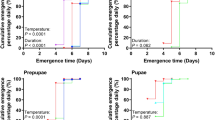Abstract
We have investigated the role of the thermo-photoperiodic condition of maternal generation in diapause induction of Trichogramma chilonis (Ishii) (Hymenoptera: Trichogrammatidae) lab strain. To test the maternal effect, two lines of T. chilonis lab strain were generated by rearing them for one generation at: (1) 15 °C with L:D-12:12 (15F-112) and (2) 15 °C with L:D-20:4 (15F-120). The laboratory strain reared at 15 °C with L:D-12:12 for 65 generations (15F-6512) was used as the control (acclimatized strain) due to its proven diapausing capacity. The 15F-120 line failed to undergo diapause, though healthy pre-pupae were formed at the pre-storage condition (at 10 °C with L:D- 8:16 and RH-60-70%). However, 15F-112 line could successfully complete all the phases of diapause and was comparable with the control batch. Considering 50% adult emergence and minimum 3 days of longevity, 125 days of storage could be achieved. From our current study, we conclude that diapause can be induced in T. chilonis lab strain by providing appropriate thermo-photoperiod to their maternal generation (for a single generation) followed by suitable diapause inducing and terminating protocols.





Similar content being viewed by others
References
Boivin, G. (1994). Overwintering strategies of egg parasitoids. In E. Wajnberg & S. A. Hassan (Eds.), Biological control with egg parasitoids (pp. 219–244). Wallingford: CAB International.
Bonnemaison, L. (1972). Diapause etsuperparasitisme chez Trichogramma evanescens Westw. (Hymenoptera, Trichogrammatidae). Bulletin de la Société Еntomologique de France, 77, 122–132.
Bossdorf, O., Richards, C. L. & Pigliucci, M. (2008). Epigenetics for ecologists. Ecology Letters 11, 106–115.
Chapman, R. F. (1998). The insects: Structure and function (4th ed.). Cambridge: Cambridge University Press.
Denlinger, D. L. (2002). Regulation of diapause. Annual Review of Entomology, 47, 93–122.
Filho, S. C. R. P., Leite, D. L. G., Soares, A. M., Alvarenga, C. A., Paulo, D. P., & Satos, T. D. L. (2014). Effects of duration of cold storage of host eggs on percent parasitism and adult emergence of each of the ten Trichogrammatidae (Hymenopteran) species. Florida Entomologist, 97(1), 14–21.
Garcia, P. V., Wajnberg, E., Pizzol, J., & Olivejra, M. L. M. (2002). Diapause in the egg parasitoid Trichogramma cordubensis: role of temperature. Journal of Insect Physiology, 48, 349–355.
Ghosh, E., & Ballal, C. R. (2017). Diapause induction and termination in Indian strains of Trichogramma chilonis (Hymenoptera: Trichogrammatidae). The Canadian Entomologist, 149(5), 607–615.
Jalali, S. K., Singh, S. P., Venkatesan, T., Moorthy, K. S., & Lalitha, S. (2006). Development of endosulfan tolerant strain of an egg parasitoid Trichogramma chilonis Ishii (Hymenoptera, Trichogrammatidae). Indian Journal of Experimental Biology, 44, 584–590.
Kostal, V. (2006). Eco-physiological phases of insect diapause. Journal of Insect Physiology, 52, 113–127.
Laing, J. E., & Corrigan, J. E. (1995). Diapause induction and post-diapause emergence in Trichogramma minutum Riley (Hymenoptera: Trichogrammatidae): The role of host species, temperature, and photoperiod. The Canadian Entomologist, 127, 103–110.
Li, L. Y. (1994). Worldwide use of Trichogramma for biological control of different crops: a survey. In E. Wajnberg & S. A. Hassan (Eds.), Biological control with egg parasitoids (pp. 37–53). Wallingford: CAB International.
Maslennikova, V. A. (1959). On the problem of overwintering and diapause of trichogrammatids (Trichogramma evanescens Westw.). Vestnik Leningradskogo Universiteta Biologiya, 14, 91–96.
Reznik, S. Y., & Kats, T. S. (2004). Exogenous and endogenous factors inducing diapause in Trichogramma principium Sug. et. Sor. (Hymenoptera, Trichogrammatidae). Entomological Review, 84, 963–970.
Reznik, S. Y., & Ovchinnikov, A. N. (2014). Cumulative induction of diapause in successive generations of Trichogramma species (Hymenoptera, Trichogrammatidae). Entomological Review, 94, 149–156.
Reznik, S. Y. A. & Vaghina, N. P. (2011). Photoperiodic control of development and reproduction in Harmonia axyridis (Coleoptera: Coccinellidae). European Journal of Entomology 108, 385–390.
Reznik, S. Y., Voinovich, N. D., & Vaghina, N. P. (2011a). Maternal influence on diapause induction in Trichogramma (Hymenoptera, Trichogrammatidae): The dynamics of photosensitivity. Journal of Applied Entomology, 135, 438–445.
Reznik, S. Y. A., Vaghina, N.P. & Voinovich, N.D. (2011b). On the Direct Influence of Photoperiod on Diapause in Trichogramma embryophagum (Hymenoptera, Trichogrammatidae). Entomological Review, 91(3), 301–305. Zoologicheskii Zhurnal, 90(5), 568–572.
Reznik, S. Y. A., Vaghina, N. P. & Voinovich, N. D. (2012). Multigenerational maternal effect on diapause induction in Trichogramma species (Hymenoptera: Trichogrammatidae). Biocontrol Science and Technology, 22, 429–445.
Saunders, D. S. (1982). Insect clocks (2nd ed.). Oxford: Pergamon Press.
Saunders, D. S., Steel, C. G. H., Vafopoulou, X., & Lewis, R. D. (2002). Insect clocks. Amsterdam: Elsevier.
Singh, S. P. (2001). Augmentative biocontrol in India. In S. P. Singh, S. T. Murphy, & C. R. Ballal (Eds.), Augmentative biocontrol-proceedings of the ICAR-CABI workshop, June 29 th to July 1 st , 2001 (pp. 1–20). Bangalore: Project Direcyorate of Biological Control.
Smith, M. S. (1996). Biological control with Trichogramma: advances, successes, and potential of their use. Annual Review of Entomology, 41, 375–406.
Uller, T. (2008). Developmental plasticity and the evolution of parental effects. Trends in Ecology and Evolution 23, 432–438.
Volkoff, A. N., & Daumal, J. (1994). Ovarian cycle in immature and adult stages of Trichogramma cacoeciae and T. brassicae (Hym.: Trichogrammatidae). Entomophaga, 39, 303–312.
Zaslavski, V. A. (1988). Insect development: Photoperiodic and temperature control. Heidelberg: Springer-Verlag.
Acknowledgements
The funding provided by the Department of Biotechnology, Government of India for this research project (code: BT/PR3339/AGR/5/558/2011) is gratefully acknowledged. The authors thank Dr. Y. Lalitha for the cultures of C. cephalonica and T. chilonis 15 °C strains. We extend our gratitude towards the editor and three anonymous reviewers of the journal, who helped us to improve our manuscript greatly.
Author information
Authors and Affiliations
Corresponding author
Rights and permissions
About this article
Cite this article
Ghosh, E., Ballal, C.R. Maternal influence on diapause induction: an approach to improve long-term storage of Trichogramma chilonis. Phytoparasitica 46, 383–389 (2018). https://doi.org/10.1007/s12600-018-0665-7
Received:
Accepted:
Published:
Issue Date:
DOI: https://doi.org/10.1007/s12600-018-0665-7




